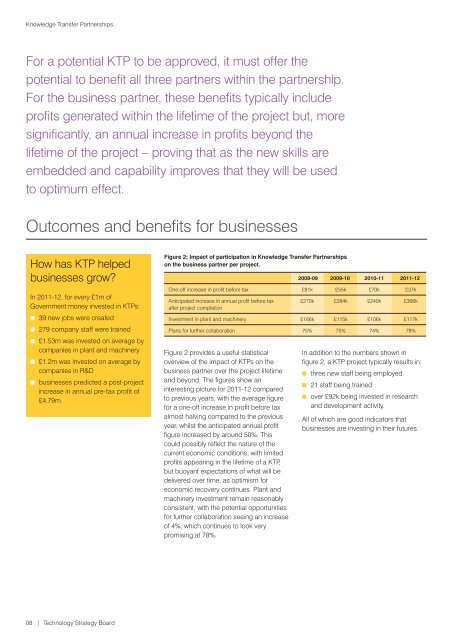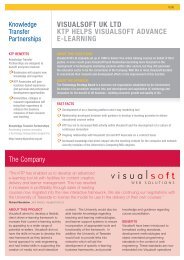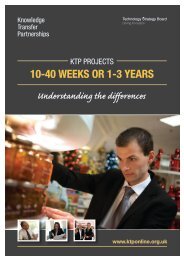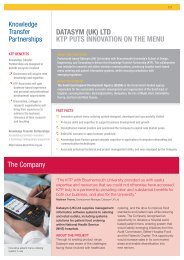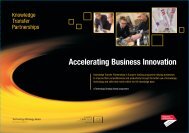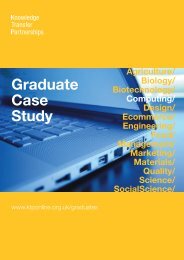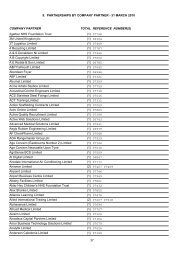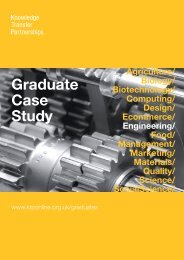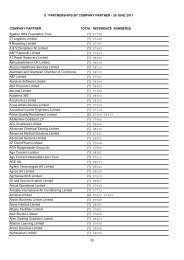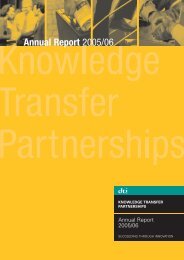Achievements and Outcomes - Knowledge Transfer Partnerships
Achievements and Outcomes - Knowledge Transfer Partnerships
Achievements and Outcomes - Knowledge Transfer Partnerships
You also want an ePaper? Increase the reach of your titles
YUMPU automatically turns print PDFs into web optimized ePapers that Google loves.
<strong>Knowledge</strong> <strong>Transfer</strong> <strong>Partnerships</strong><br />
For a potential KTP to be approved, it must offer the<br />
potential to benefit all three partners within the partnership.<br />
For the business partner, these benefits typically include<br />
profits generated within the lifetime of the project but, more<br />
significantly, an annual increase in profits beyond the<br />
lifetime of the project – proving that as the new skills are<br />
embedded <strong>and</strong> capability improves that they will be used<br />
to optimum effect.<br />
<strong>Outcomes</strong> <strong>and</strong> benefits for businesses<br />
How has KTP helped<br />
businesses grow?<br />
In 2011-12, for every £1m of<br />
Government money invested in KTPs:<br />
39 new jobs were created<br />
279 company staff were trained<br />
£1.53m was invested on average by<br />
companies in plant <strong>and</strong> machinery<br />
£1.2m was invested on average by<br />
companies in R&D<br />
businesses predicted a post-project<br />
increase in annual pre-tax profit of<br />
£4.79m.<br />
Figure 2: Impact of participation in <strong>Knowledge</strong> <strong>Transfer</strong> <strong>Partnerships</strong><br />
on the business partner per project.<br />
Figure 2 provides a useful statistical<br />
overview of the impact of KTPs on the<br />
business partner over the project lifetime<br />
<strong>and</strong> beyond. The figures show an<br />
interesting picture for 2011-12 compared<br />
to previous years, with the average figure<br />
for a one-off increase in profit before tax<br />
almost halving compared to the previous<br />
year, whilst the anticipated annual profit<br />
figure increased by around 50%. This<br />
could possibly reflect the nature of the<br />
current economic conditions, with limited<br />
profits appearing in the lifetime of a KTP,<br />
but buoyant expectations of what will be<br />
delivered over time, as optimism for<br />
economic recovery continues. Plant <strong>and</strong><br />
machinery investment remain reasonably<br />
consistent, with the potential opportunities<br />
for further collaboration seeing an increase<br />
of 4%, which continues to look very<br />
promising at 78%.<br />
2008-09 2009-10 2010-11 2011-12<br />
One-off increase in profit before tax £81k £55k £70k £37k<br />
Anticipated increase in annual profit before tax £270k £284k £240k £366k<br />
after project completion<br />
Investment in plant <strong>and</strong> machinery £166k £115k £106k £117k<br />
Plans for further collaboration 75% 75% 74% 78%<br />
In addition to the numbers shown in<br />
figure 2, a KTP project typically results in:<br />
three new staff being employed<br />
21 staff being trained<br />
over £92k being invested in research<br />
<strong>and</strong> development activity.<br />
All of which are good indicators that<br />
businesses are investing in their futures.<br />
08 | Technology Strategy Board


